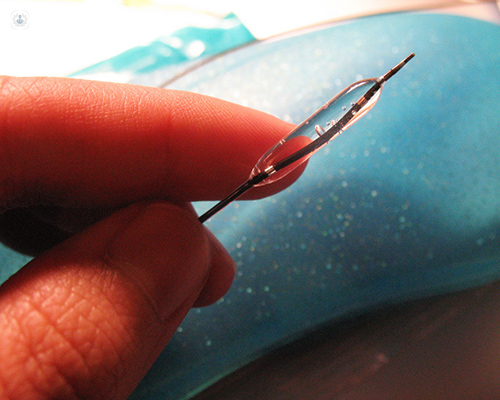Coronary angioplasty and stenting – From diagnosis to aftercare
Escrito por:
Coronary angioplasty (now known as percutaneous coronary intervention or PCI) is a procedure designed to help symptoms of angina by unblocking blood vessels in the heart in order to improve the blood supply in the heart. A small balloon is introduced via a catheter and positioned across a narrowing in the artery, stretching the blocked artery to allow better blood flow. A stent (small metal scaffold) is then introduced to keep the artery open.

Why do arteries become blocked?
Arteries carry oxygenated blood around the body. Normal healthy arteries are smooth and unobstructed, allowing normal blood flow.
As people age, fatty deposits called atheroma or atherosclerosis may build up on the inside of arteries, producing narrowings that reduce the blood supply to areas of the heart. These develop slowly over time and are more likely to occur in people who smoke, people who have diabetes, people with high blood pressure, and people with high cholesterol.
What are the symptoms of a blocked coronary artery?
The most common symptom of having a narrowed or blocked artery is angina. This is described as tightness in the chest or heaviness that may move to the left arm or throat. Angina is normally brought on by exercise and relieved within a few minutes by rest. Angina occurs when not enough blood can pass through the narrowings in the heart.
For most people, angina is not a particularly troubling symptom and may be treated with medication alone. However, for many people, further treatment such as angioplasty and stenting is required.
Anyone with a prolonged episode of chest pain lasting more than 15 minutes should seek emergency medical attention.
What is the coronary angioplasty?
- A small catheter (a flexible plastic tube) is inserted under local anaesthetic into the artery, either at the wrist or in the groin.
- The catheter is placed under X-ray guidance into the coronary arteries.
- A fluid called contrast medium is injected through the catheter that allows the arteries to show up on X-ray. These pictures are called a coronary angiogram.
- Using the angiogram images, the cardiologist is able to identify if there are any blockages in the coronary arteries that require treatment.
- A fine wire is then passed across the tight narrowings identified before a small balloon is positioned across the blockage. This is then inflated at high pressure, compressing the fatty tissue, reopening the artery and allowing blood to flow more freely.
- Once the artery has been ballooned, a stent (a small wire mesh or scaffold) is placed across the site of the narrowing to keep the artery open. The stent is introduced on a balloon that is then inflated in position before the balloon is removed, leaving the stent in place.
- The procedure usually lasts between 30 minutes and 2 hours depending on the complexity.
Is coronary angioplasty painful?
The procedure causes little pain. The area where the catheter is inserted is numbed to reduce pain, but may feel a little sore afterwards. As the balloon is inflated, patients may feel mild chest pain (angina) as the balloon is inflated, but this is normal and will be gone once the balloon is deflated after a few seconds and the artery is opened up.
What happens after the procedure?
Following the procedure, most people are discharged the same day, although sometimes patients stay overnight for monitoring.
Heavy lifting should be avoided for 2-3 days after the procedure, especially if the catheter is introduced from the leg. Driving is not allowed for at least one week.
Following angioplasty and stenting, the symptoms of angina are greatly improved.
For patients who have had a heart attack, coronary angioplasty will reduce the chance of having another heart attack in the future.


